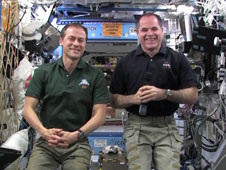Feature
Text Size
Crew Opens Cargo Craft Hatch
02.12.13

Flight Engineer Chris Hadfield works with a laptop aboard the International Space Station. Credit: NASA TV
The Expedition 34 crew of the International Space Station focused Tuesday on conducting science experiments, upgrading hardware and opening the hatch to a newly-arrived Russian space freighter.Prior to the crew’s daily planning conference with flight control teams around the world, Commander Kevin Ford began his day speaking with students at Breadalbane Academy in Aberfeldy, United Kingdom, via ham radio and answered questions about living and working in space.
Afterward Ford began the first of several days’ effort to refill cooling loops in the Internal Thermal Control System in the Destiny laboratory.
Flight Engineer Tom Marshburn packed various items into stowage bags for return to Earth aboard the SpaceX Dragon commercial cargo craft, set to launch early March. Dragon is the only vehicle in the station’s cargo fleet that not only takes cargo to the station, but also brings back cargo and experiment samples to Earth.
Next, Marshburn calibrated the gas management system of the Pulmonary Functioning System. This hardware, part of a collaborative effort between NASA and the European Space Agency, acquires a variety of respiratory and cardiovascular measurements to monitor the pulmonary physiology of the astronauts during their long duration missions.
› Read more about the Pulmonary Functioning System

Commander Kevin Ford (right) and Flight Engineer Tom Marshburn talk with reporters from WBOI Radio in Ft. Wayne, Ind., and News 14 Carolina. Credit: NASA TV
Marshburn took a break from his work to join Ford for live interviews with WBOI Radio in Ft. Wayne, Ind., and News 14 Carolina. The two NASA astronauts discussed the challenges of living in space and the experiments taking place aboard the station with the reporters based in their home states. Ford is an Indiana native, while Marshburn hails from North Carolina.Marshburn rounded out his day installing an HD video camera in the Columbus laboratory.
Flight Engineer Chris Hadfield of the Canadian Space Agency spent his morning working with the Binary Colloidal Alloy Test science payload, which takes a look at colloids -- microscopic particles suspended in a liquid -- and may lead to improvements in manufacturing processes here on Earth.
› Read more about Binary Colloidal Alloy Test-C1
Hadfield also replaced a sample cartridge in the Solidification and Quench Furnace inside the Materials Science Research Rack and swapped out the Vehicle Cabin Atmosphere Monitor (VCAM) locker from EXPRESS rack 2 for return to Earth aboard Dragon. VCAM identifies minute quantities of harmful gases inside the station.

The ISS Progress 50 cargo vehicle docks to the International Space Station's Pirs docking compartment. Credit: NASA TV
All three cosmonauts on the Russian side of the station – Flight Engineers Evgeny Tarelkin, Oleg Novitskiy and Roman Romanenko – turned their attention to the ISS Progress 50 cargo craft, which docked to the Pirs docking compartment at 3:35 p.m. EST Monday as the station soared over the Caribbean Sea, southwest of Puerto Rico. Its arrival capped a flawless, accelerated 6-hour trek from the launch pad at the Baikonur Cosmodrome to the station.› Read more about the launch and docking of Progress 50
Following leak checks at the docking interface, Romanenko and Novitskiy opened the hatch to the Progress shortly after 7 a.m. Tuesday, allowing the crew to begin unloading more than 2.5 tons of cargo. Once emptied, Progress 50 will be filled with trash and station discards like its predecessors and undock in April for a destructive re-entry over the Pacific Ocean.